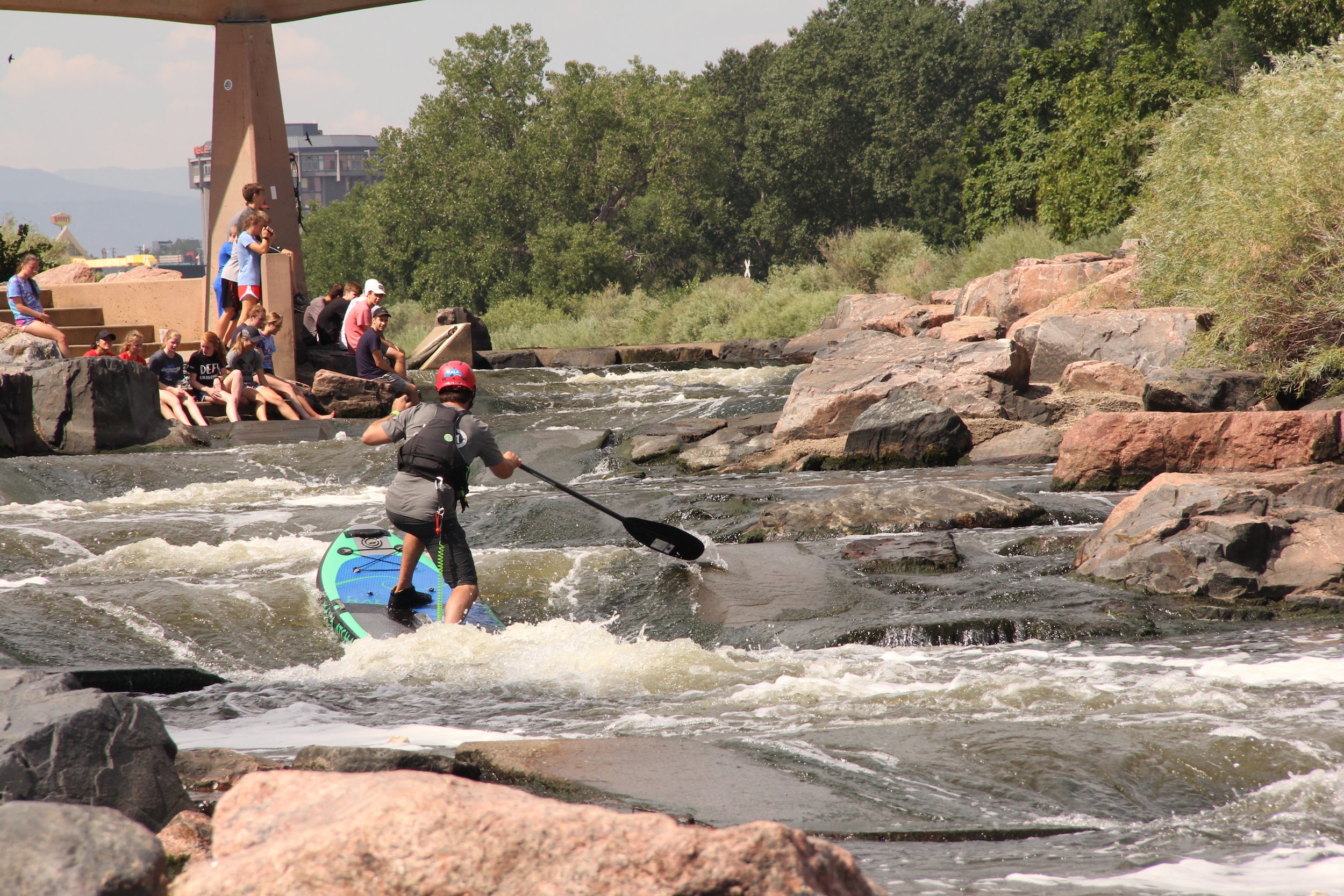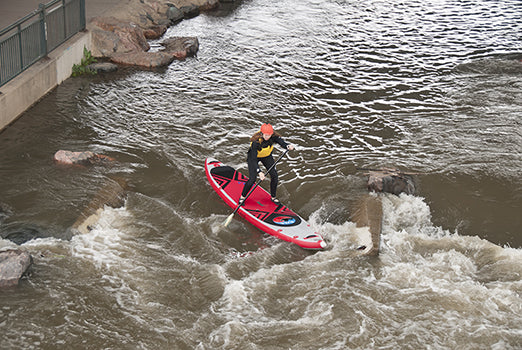
How to Run the Confluence Course in Denver
One of the great things about living in Denver is the whitewater course at Confluence Park. The man-made chute on river right is a series of challenging drops made of concrete and placed rock that can be run year-round. The drop should be run by beginners kneeling down, while those with a little more experience will have fun running laps on the section.
This spring has been unusually wet and the South Platte has been running. Even the sidewalks were flooded. After taking a look at the river with other members of the Colorado SUP Club we thought it might actually be a little easier at this level. The line was pushy, but still straight down the middle and much more padded out.

The Hala Atcha is made for whitewater like the Confluence Course. Wide and stable, it is still able to drive on its edge. That edge, combined with the boards quad fin setup, allows you to move exactly where you need to go.
The rest of us were cruisin’ on the Hala Nass, where speed and size is the name of the game. The long 12’6” board allows you to drive through the course and stay on rails. Its speed allows paddlers to power through some of the boogie water you find throughout the second half of the course.
Below is Cami Swan entering the course. She is driving from river right to river left as she enters the top of the course with a strong right paddle stroke. You will want to make sure to switch to a forward driving left paddle stroke on the next stroke or two to line yourself up for the center-right portion of the first big drop.

You will want to skirt the eddy line on the left to prevent it from stealing some of your speed.

What's the proper technique on a small drop? Your legs should be bent to absorb the impact, paddle out in front, ready to insert and grab the water of the feature to give stabilization. This wave is angled from river right to river left and will want to move your board to river left, so your paddle will enter on river left to counteract that movement and keep your board pointed downstream.

Try to barely hit that foam pile. Insert your paddle in front of you and drive through the wave. The paddle should form a tripod that engages your core down through your heels as you power through and start driving to the right-center of the chute.

After you have driven to the center-right and are approaching the next big reactionary wave, the right wave is going to grab the front of your board and push it left. The center-right line is the fastest at this level and you will want to make sure you can pull yourself over there. So, set up your approaching paddle stroke on the right side.

Reach over and grab the backside of the wave with your paddle. The waves will try and turn your board and your job is to keep that bad boy pointed straight downstream. To do that, engage your core and make sure the strongest part of the snap-in your stroke is when your board is on the top of the wave. The majority of the board is out of the water at that point and you will be able to really turn the Hala Nass on a dime because of the built-in rocker. On bigger waves, you can even get the fins out of the water and the Nass turns into a top! Using the rocker and timing your strokes to take advantage of minimal surface resistance is a key skill in river racing.
The two reactionary waves colliding cause some boogie water. Make sure to get that core engaged and plant some powerful strokes to stay within your line.
As you approach the drop before the big eddy on river left, you should line up for the middle. The chutes were made for kayakers and tubers. The course was channelized in the center to allow navigation at very low flows. Kayaks slide over the concrete that forms the sides of the drops in the chute. Your fins don’t!
By now you should be really cruising. While it is normally fun to take a lap in the big eddy on the left, we are on a race board so we are going to not stop and keep on paddling. The remaining drops at this water level are mostly washed out. Make sure to engage your core through your heels in the boogie water, keeping your paddle cadence up. The nice stiff rocker to the Hala Nass allows you to make small adjustments, so make sure to keep your board pointed downstream. Try to sneak in some extra momentum by pumping the backside of the waves.

This river is a great place for beginners to learn great skills. Try starting further down on the course and slowly working your way up as you get more comfortable. Reach out to the friendly folks at Confluence Kayaks which is right there next to the park for lessons, gear rentals, or to get your own Hala Nass.
John Blackshire is a team rider for Hala Gear.



Leave a comment
This site is protected by hCaptcha and the hCaptcha Privacy Policy and Terms of Service apply.